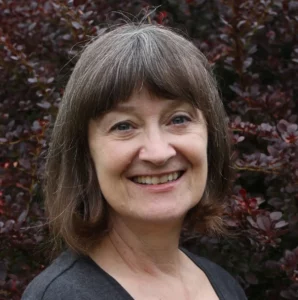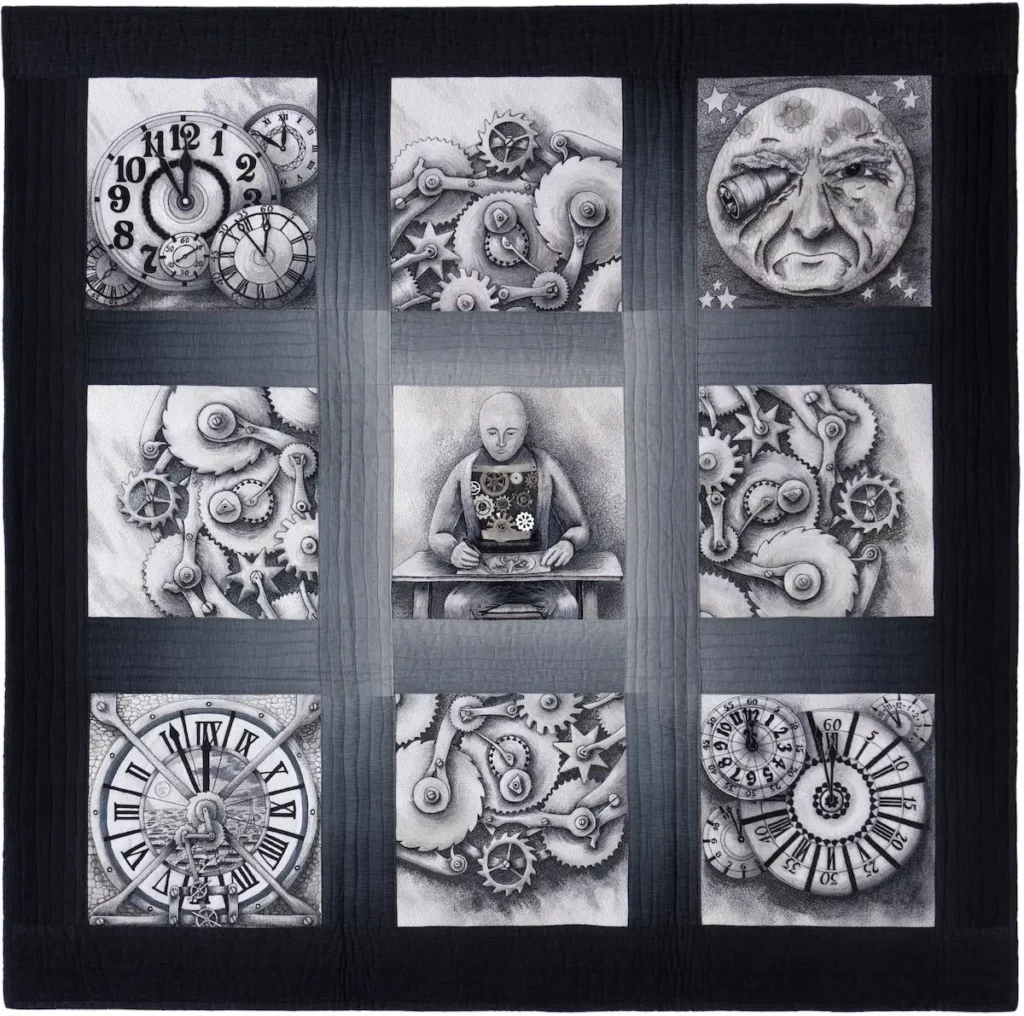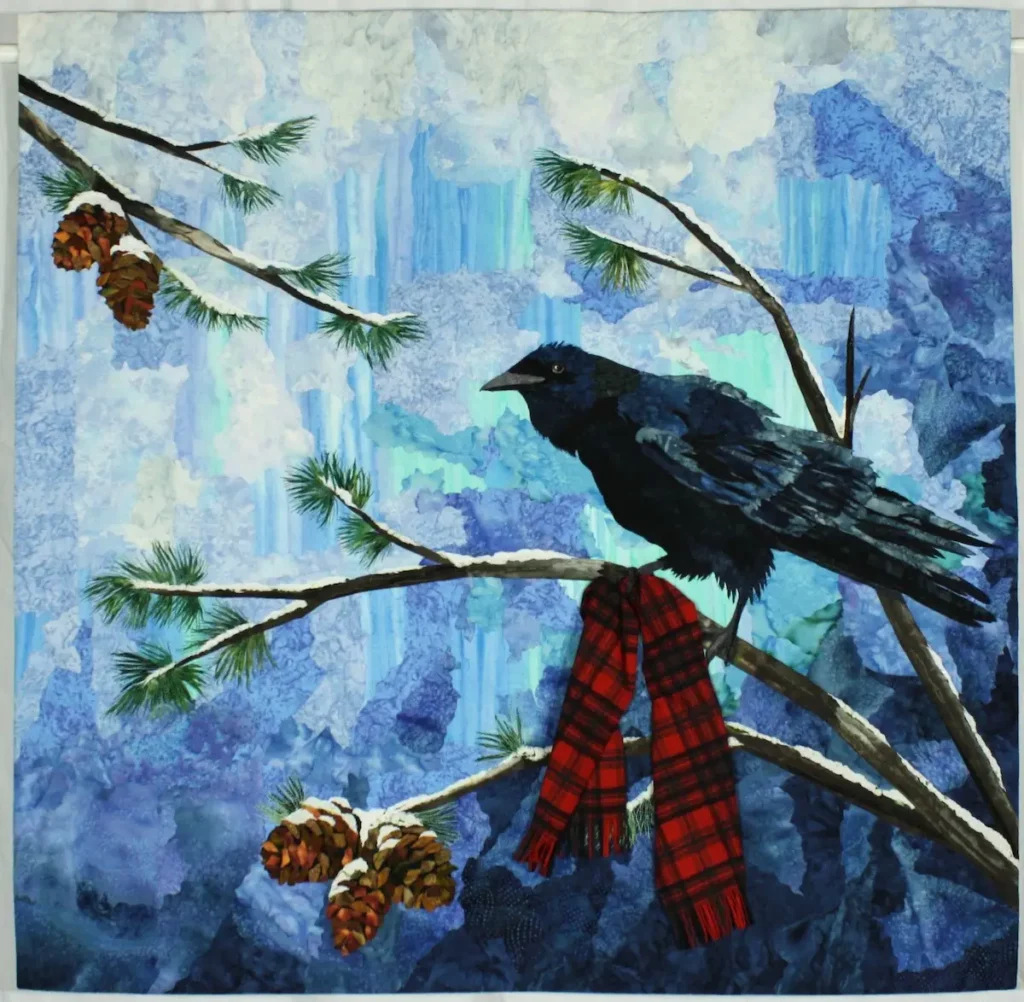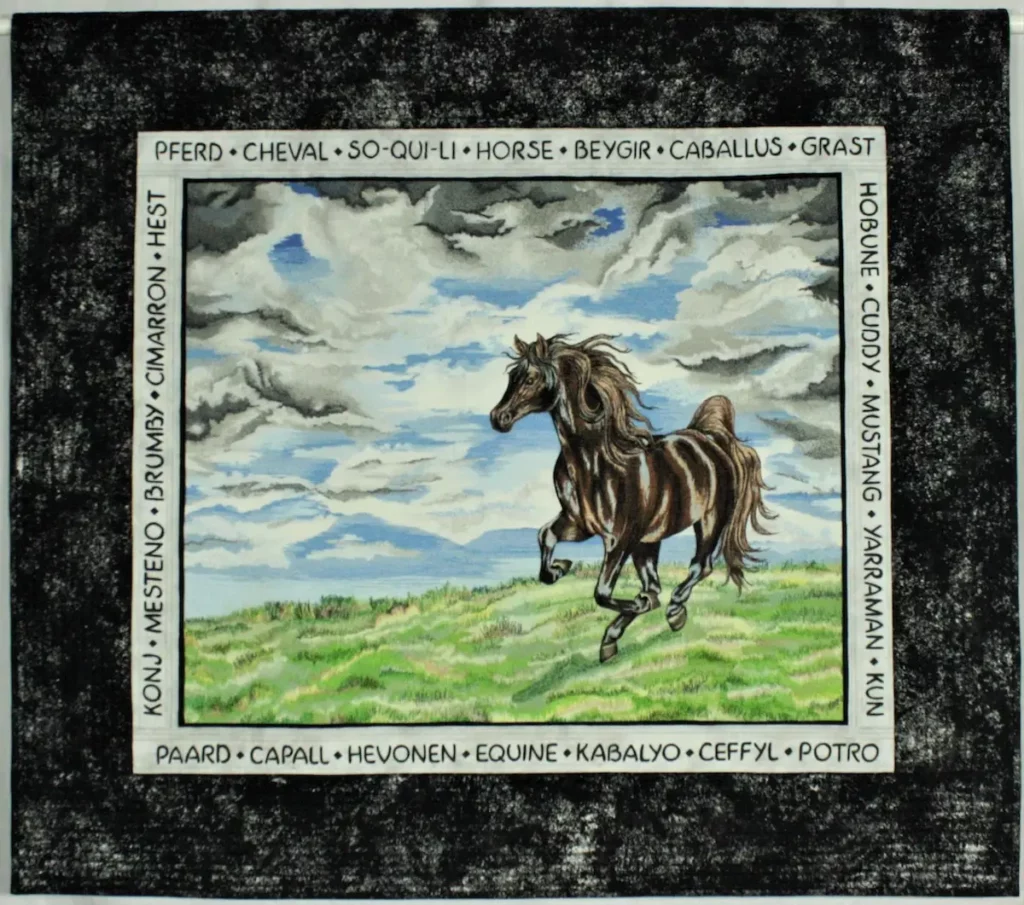Judith Phelps focuses on the details in creating her art quilts, using a variety of techniques to catch the viewers attention. She enjoys challenges from her fiber art groups to create her intricate pieces, sometimes working until the very last minute.

How did you find yourself on an artist’s path?
I have always had the desire to create. I have experimented with pencil and paper, brushes and paint, needle and thread, clay, lettering, and assorted crafts. I make owls, snowmen, embroidered bears and assorted critters for Christmas Bazaars. As a young child I can remember drawing a person on a piece of paper and asking my mother, “I can’t get the hands right – can you draw them?” When she informed me she couldn’t, I determined that someday I would be able to draw hands.
In high school I took classes in calligraphy, art, and learned to sew clothing in home economics. I have taken community classes and classes at community colleges when time allowed to give myself more knowledge and skills. I have an associate degree, but the college I attended did not offer art classes.

42″ w x 48″ l
Made: 2022
Storytellers theme: Name that Tune
Thread Tales and Art Quilt Group book challenge: My Grandmother Asked Me to Tell You She’s Sorry by Fredrik Backman
The original design is from the description of the fairy tale land in the book. To get to this land, one rode in on cloud animals. The six kingdoms or towns are represented by different color combinations. Of course, there are always castles, warriors and dragons in fairy tales. The song speaks of warriors that build towns from dust and will have to rise above the best and prove themselves – Their spirit never dies.
Techniques: fused raw edge appliqué (stitched with invisible thread), mountains, man, guardian dogs (wurses), and river were hand painted on another fabric and appliquéd on; sky and water were painted on the quilt top, quilted on domestic machine.
Why has my art path taken me to quilting?
As an Amazon Associate I earn from qualifying purchases. Read more about our affiliate linking policy.
I began art quilting because of the challenge. Paint a picture on paper or canvas, frame it and the art piece is finished. Paint on fabric and you still have a full set of steps to complete: sandwiching the top with batting and backing fabric, finding a quilting design that complements the quilt top, quilting the quilt, binding or facing the quilt and adding that important label. I find satisfaction in working with fabric. It can be manipulated, has texture, and when thread adds the finishing touch there is a sense of delight.
A finished quilt that I can be proud of is what I strive for, but I love the process of getting there. My father was constantly remodeling our homes and I remember as a child watching him contemplating how to achieve what he could see finished in his mind. I’ve learned that trait from him and love the challenges of incorporating what I already know with a new technique or idea.

45” w x 35” l
Made: 2018
Storytellers theme: Cities
Thread Tales book challenge: The Art Forger by BA Shapiro
This book deals with the forgery of famous paintings.
I wanted to see if I could paint a section of Vermeer’s Delft on fabric. I loved seeing this ‘city’ through Vermeer’s eyes and trying to replicate it. His attention to detail was amazing. Notice the lightning rods on the buildings!
Techniques: drawn on fabric and painted with Jacquard Fabric Paints, quilted on domestic machine
What do you do differently? What is your signature that makes your work stand out as yours?
The phrase ‘the devil is in the details’ doesn’t register with me because the details are what makes art sing for me. My husband tells me I go overboard with details, and he is right, I do.
It always amazes me what more you can see if you take the time to look. The way a shadow will play in the leaves, or how a spider web will have dew drops on it in the morning can be details that have to be in a quilt.
I’m not sure I have a signature that makes my work stand out, sometimes it is the details that will grab the viewer’s attention and the person will stop and take a second look I will use a variety and combination of techniques on one quilt. Appliqué, paint, thread painting, piecing and 3D objects can all be included in one quilt. I love the sheen and texture of thread, and will often thread paint a whole quilt if I have time. It is one of my favorite techniques.

39” w x 44” l
Made: 2012
Art Quilt Group challenge: new techniques and layers
Cover to Cover Book Club Quilters challenge: Prayers for Sale by Sandra Dallas
Mining towns left the landscapes and lives changed. Once the mines stopped producing, the towns were abandoned, but the stories lived on in the memories of the men and women. I tried to convey a feeling of time and isolation.
Techniques: original design began with flower pounding, appliqué , painting, embroidery, trapunto, 3D leaves, stumpwork spider, metal work (windmill) and plastic for broken window.
What inspires you to create? Where do you find the inspiration for your designs?
The color, beauty and diversity of God’s creation astonishes me. Often, just looking at cloud formations will inspire me, or the different colors of blue will catch me by surprise. A photo of an insect can catch my attention. Some beetles have the sheen of metals and myriads of colors and designs on their shells and they come in all shapes and sizes. Nature is an endless smorgasbord of inspiration.

39” w x 41” l
Made: 2016
Cover 2 Cover Book Club Quilters Challenge: All the Light We Cannot See by Anthony Doerr
Marie-Laure lost her eyesight at the age of six but in her imagination and dreams everything has color. Trees in her imagination are shimmering kaleidoscopes full of light.
Techniques: original design, the quilt was made to be viewed from both sides, has three layers and is completely thread painted except for the outer borders.
I also belong to several small quilting groups that have three or four challenges a year. When you belong to more than one small group, you tend to try to combine some of the challenges and this has inspired more than one quilt. The Value of Gears started out from a book club challenge as a whole cloth thread painted quilt and then became a nine-block thread painted quilt because of a “series of three” challenge from another group.

51” w x 51” l
Made: 2013
Cover 2 Cover Book Club Quilters challenge: The Invention of Hugo Cabret by Brian Selznick
Art Quilt Group challenge: a series of three
The drawings are original but based on the book. The thread painting in this quilt was on a ‘value scale’ to reflect the artwork in the book. The gears, clocks, mechanical man and rocket interlock the blocks of this quilt. The quilt is made to be viewed from both sides. The gears inside the mechanical man are metal.
The quilters in my small groups spur me on to improve my quilting and inspire me in directions I may not even think of trying.
Tell us about the Storytellers small group.
I started making art quilts around 2012 and I was asked to join these ladies about the same time. My husband’s comment when I told him was, “You said you wanted to improve your quilting. This is how you do it.”
They are a wonderful group of ladies to learn from. We spend time exhibiting quilts as a group and will often spend the day at the exhibit talking to the public. They are willing to share their expertise in quilting and are a good sounding board when searching for just the right answer to a problem in a quilt. I am known in all my quilting groups for ‘just making the deadline’ for a project but because of my respect and sense of responsibility to these ladies I will usually get a quilt finished.

45” w x 50” l
Made 2021
Storytellers theme: Seeing Red
Thread Tales book challenge: The Nightingale by Kristin Hannah
The story takes place in France during World War Two. A young woman ties three red ribbons to an apple tree in her front yard for: Antoine, her husband taken as prisoner of war; Rachel, a Jewish best friend forced into a cattle car; and Sarah, a young Jewish girl shot and killed. The stone wall around the apple tree has been torn down by the Germans. The ribbons represent a promise to never forget.
Techniques: original design lightly painted on a whole cloth top, thread painted with rayon thread for snow and cotton thread for everything else, made on a domestic machine
Do you plan your work out ahead of time or just start playing?
I am methodical in my methods. I will start with multiple idea drawings in a journal. After I have one that I am pleased with I draw and enlarge the design on paper (so I can erase a lot) and when satisfied will transfer it to the fabric. It is at this stage that I usually decide what techniques I will use and sometimes that decision is based on a time deadline. I also think about color choices, value placements and design choices at this stage.

42”w x 42” l
Made: 2019
Storytellers theme: Seeing Red
Thread Tales book challenge: The Snow Child by Eowyn Ivey
A child’s red winter scarf had disappeared. “Ravens…and other wild birds had been known to snatch things.” The inspiration for the design of this quilt came from this sentence.
Techniques: appliqué, some paint and thread painting, the scarf is 3D
Unfinished projects?
When I started quilting, I attended Block of the Month clubs that concentrated on traditional blocks, so I have a few quilt tops that need to be sandwiched and quilted and a few extra blocks that are available for use. Anytime I make a quilt, I want the quilt to be my work from the beginning to the end. I feel that the quilting on a quilt is just as important as making the top, so I do have some UFO’s I hope one day to complete.
When was the first time that you remember realizing that you are a creative person?
I’ve always known that I can create for my own accomplishment, but I think anyone who creates wants the satisfaction of knowing their work is appreciated by other people. For me, this validation came when ‘The Value of Gears’ received the Moda Best Wall Quilt Award in the Paducah AQS quilt show in 2014. I love that what I create might speak to others or at least might make them stop and take a second look.

Are there reoccurring themes in your work?
Horses are a reoccurring theme in my quilts. I am drawn to the beauty of their eyes, mane and tails flying in the wind and the sense of freedom I get from them. I am also drawn to scenes that have a sense of time, solitude or give a sense of past experiences. Old homes or buildings always makes me wonder about the lives lived and the hopes and dreams of the past.

39” w x 35” l
Made 2015
The word ‘horse’ in different languages surrounds the thread painted horse, land, and sky. The quilt is an original design and made to be viewed from both sides. The lettering is readable on both sides.
Techniques: original design, lightly painted and then thread painted, the lettering was hand guided thread painted twice so the lettering would be readable on both sides.
I do love color but will often work in white and black values or sepia values.

32” w x 32” l
Made: 2012
Art Quilt Group challenge: Zentangle design
The mane of a horse was the first thing I thought of for a zentangle design, so I drew the horse with the idea of his mane being thread painted zentangles. Shading in the quilt is with thread painting and some light color pencil shading on the face. The background is white with white zentangle designs.

26” w x 50” l
Made: 2018
Storytellers City theme: Cities
Made from a photo from “I was a Portland Kid” on Facebook (with permission) Circa 1940’s? Portland had a baseball field on Vaughn St. from 1901 – 1956. Jim Thorpe, Joe DiMaggio, and Ted Williams were a few of the players who played there.
Techniques: appliqué – sewn down with invisible thread, painted faces, hands, and legs appliquéd on
Do you have a dedicated space for creating?
I do. We have lived in our home in Battle Ground, WA for 33 years, so my children used the bonus room over our garage during their years at home. I never dreamed at that time it would become my art and sewing room one day. I am blessed. I have one large table set up for cutting fabric etc., one table set up for painting and general artwork, two sewing machines are set up and ready for use at any moment and fabric, craft and art supplies fill up the room. Our computer is also in the bonus room, so I do share the room with my husband.
If we asked a good friend of yours to describe your work, what would they say?
I asked a couple of close friends this question. I was curious.
Responses:
Judith’s work is amazing. She continues to surprise us with unique and varied techniques. The details in her work draw viewers into her art. I can’t pick a favorite. She’s been “wowing” me for over a decade. I’m so happy to see her garnering some national recognition for her talent. Watch out world because Judith will continue to “knock your socks off.”
It’s awesome to watch Judith’s creative design processes – the details and accuracy for which she strives. I appreciate the fact that she is always willing to share and to teach.

How has your work changed over time?
I’m not sure that it has changed in content. I still make quilts from ideas that inspire me. I do feel that I have improved in technical skills. Borders and sashing being straight, outside edges of the quilt lying flat and straight, corners being at right angles and bindings or facings sewn down well are important when you want an art quilt to hang well. I do still have work to do in all these areas. My free motion quilting has improved and watching quilting designs come to life is always a joy.
Where can people see your work?
Interview posted April 2023
Browse through more art quilts and inspiration on Create Whimsy

